Courthouses serve as a proud architectural landmark. However, because of the sensitive nature of the work that occurs in these landmark buildings, as well as a rise in civil unrest and anti-government sentiment sweeping the nation, courthouses are faced with unique security threats. Court staff are challenged to administer justice in buildings that are open to the public while also protecting the safety of judges, staff, jurors, and courthouse visitors.
Adopting the principles of Crime Prevention Through Environmental Design (CPTED) - which involves applying physical design features to discourage crime while at the same time encouraging legitimate use of the built environment - can be an effective approach for maximizing security at your courthouse.
CPTED includes four main strategies – territorial reinforcement, natural surveillance, natural access control, and maintenance. Territorial reinforcement, sometimes called “defensible space,” uses physical attributes to create clear boundaries and demonstrate a strong sense of ownership and territorial control. This sense of control sends a strong signal to potential offenders that the space will be defended and protected.
Let’s take a closer look at how strong boundaries around your courthouse can serve as an effective crime prevention strategy.
The Role of Strong Courthouse Boundaries
Buildings that successfully employ boundary reinforcement strike the fine balance between inviting legitimate users to the space and sending a clear message that users with an illegitimate purpose are not welcome.
Several design elements can be applied to achieve strong boundaries, including a celebrated entrance, fencing, bollards, signage, lighting, artwork, and landscaping. The image below represents a courthouse design that provides strong boundaries using these techniques.
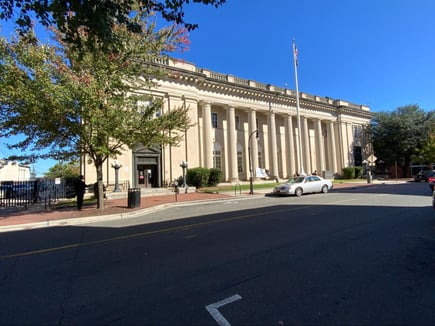 Strong courthouse boundaries
Strong courthouse boundaries
In contrast, the rear of the courthouse in the image below does not have a strong sense of boundaries and lacks the impression of ownership. There is no clear demarcation of public, semi-private, and private zones. Lighting is inadequate and there is no landscaping or signage.
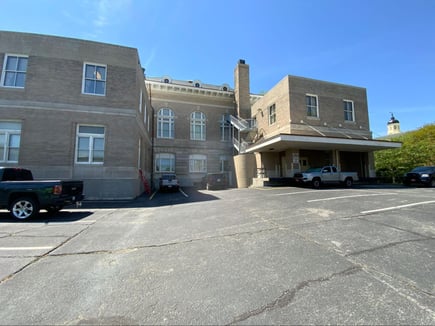 Poor courthouse boundaries
Poor courthouse boundaries
CPTED Strategies for Creating Strong Boundaries
Let’s explore in more detail some approaches that can be applied to create well-defined boundaries and a strong sense of ownership at your courthouse.
Celebrated Entrance. It’s important to accentuate the main entrance of the courthouse with architectural elements to guide visitors and create a clear boundary between the transition from non-courthouse space to courthouse space. Some features that can be used to clearly define the main entrance and create a celebrated entryway include signage, lighting, decorative elements, and monumental design. A clearly defined main entrance is a strong expression of ownership and can limit the number of building users who may wander into unauthorized areas of the courthouse.
The image below provides an example of a celebrated entrance.
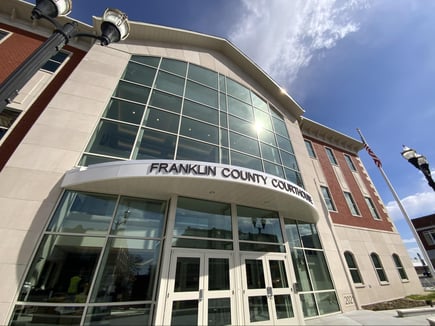 Example of courthouse entrance to establish clear boundaries
Example of courthouse entrance to establish clear boundaries
Fencing. Installing fencing can be an important part of your strategy to create strong boundaries around your courthouse. Fencing can help define courthouse property and create a clear demarcation between the non-courthouse and courthouse zones. Fencing can make it more difficult for potential offenders to trespass in unauthorized areas.
It’s also important to consider the type of fencing used. Fencing that meets CPTED recommendations is typically a minimum of six feet high and transparent to provide clear sightlines. Suggested fencing materials include tubular steel and wrought iron. The fencing should also have an anti-climb design, which doesn’t permit footholds.
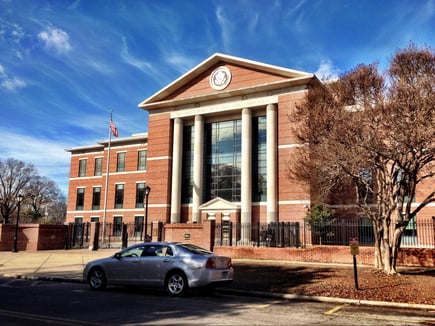 Example of fencing to establish clear boundaries
Example of fencing to establish clear boundaries
Bollards. Installing bollards around the perimeter of the courthouse, as well as near parking lots and sidewalks, creates a protective perimeter and provides a controlled traffic setting. Bollards can guide traffic, establish clear boundaries, and create a strong sense of control. As an attractive alternative to bollards, hardened planters or hardscaped walls could be used.
Lighted bollards, such as those in the image below, help illuminate the building exterior and pathways leading to the courthouse. Lighted bollards provide strong reinforcement of courthouse boundaries at night.
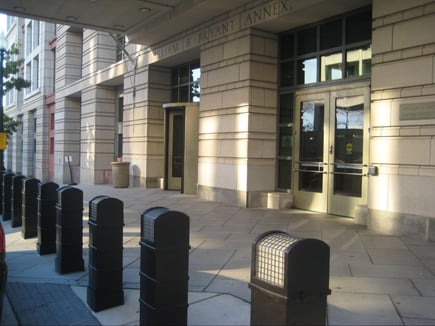 Example of lighted bollards to establish clear boundaries
Example of lighted bollards to establish clear boundaries
Signage. Providing highly visible signage is another way to create boundaries and promote a strong sense of control at your courthouse. The courthouse facade should display the building’s name and address to create a sense of ownership. Pedestrian-scale signage should be visible throughout the courthouse property to improve wayfinding and to provide directives and expectations regarding the building’s use and organization.
Directives should be easily understandable with large, bold fonts and graphics. Signage should be provided on all exterior doors and should direct visitors to the main entrance and notify them of electronic surveillance. Signage should be designed such that it limits areas of concealment and does not interfere with sightlines. All signage should be illuminated at night.
 Example of signage to establish clear boundaries
Example of signage to establish clear boundaries
Artwork. Incorporating artwork is another effective way to enhance boundaries at your courthouse. Public art comes in many forms and can help define and activate a space and serve as a focal point for a site. Sculptures, fountains, flags, and plazas are some ways to add artistic features to your courthouse exterior.
Be sure that artwork is reflective of the local culture or expresses some meaningful symbolism so that courthouse users can strongly identify and connect with it.
Artwork is often used to tell a story. The concept of “blind justice” is represented in the artwork shown below, which is displayed outside a Newark, NJ courthouse.
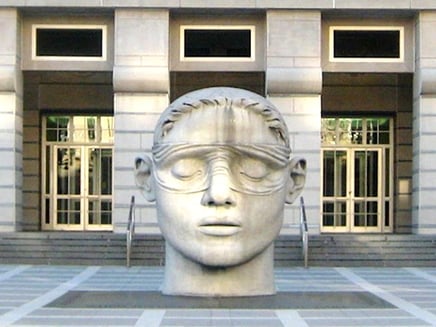 Example of public art to establish clear boundaries
Example of public art to establish clear boundaries
Lighting. Adequate lighting helps guide users to the main entrance of the courthouse and makes them feel more comfortable in their surroundings. All pedestrian access walkways and access routes should be illuminated to provide a clear path of travel.
Pedestrian-scale lighting and illuminated bollards may be used on the courthouse exterior to guide users and prevent shadowy hiding places. A best practice is to conduct a lighting survey to ensure that lighting complies with Illuminating Engineering Society (IES) standards.
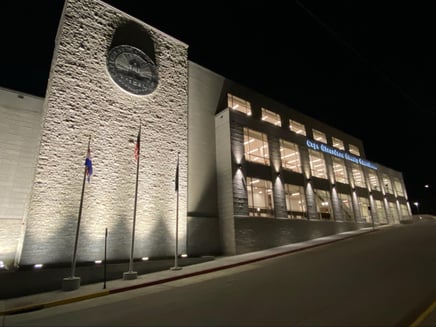 Example of good lighting to establish clear boundaries
Example of good lighting to establish clear boundaries
Landscaping. Landscaping can be an effective way to define boundaries and express ownership. Marking the property's boundaries using landscape features such as a tree line or hedge can deter illegitimate users from entering the site. Consider hiring a landscape architect to develop the most effective design that establishes clear boundaries at your courthouse.
Note that it’s important that your landscape design allows for unobstructed views of the surrounding area. And be sure to develop a maintenance plan for any landscaping features to preserve sightlines, prevent hiding places, and signal to users that there is a sense of ownership at the courthouse.
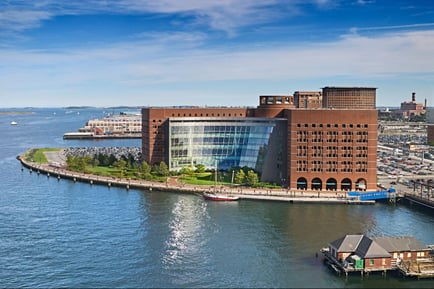 Example of landscaping to establish clear boundaries
Example of landscaping to establish clear boundaries
One Piece of the Overall Approach
This article focuses on using CPTED strategies to create strong boundaries surrounding your courthouse to send a clear message to unauthorized users that the space is well protected. Creating strong boundaries is one approach to enhancing courthouse security.
The methods described in this article are most effective when used as part of a comprehensive crime reduction strategy that includes the application of the other CPTED principles - natural surveillance, natural access control, and maintenance - in conjunction with physical and electronic security measures. Together, these strategies create a courthouse setting that is safe for judges, staff, and the public.



.jpg)

.jpg)
.jpg)
.jpg)
.jpg)
.jpg)
.jpg)
.jpg)
-1.jpg)
.jpg)
.jpg)
.jpg)
.jpg)
.jpg)

